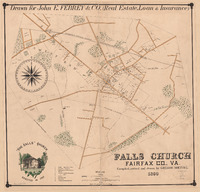Tinner Hill
Tinner Hill is an early example of racialized displacement in Northern Virginia due to a mixture of racial exclusion, expansion, and development – often in the name of progress. The experience of the Black community of Falls Church during the late nineteenth-century established a pattern for the experiences of the people who lived in and around Tinner Hill in the coming decades. The actions of the white Town Council members, and land developers sow the seeds that created a narrative of progress in the twentieth-century. The land originally purchased in September 1890 by Charles Tinner and its surrounding community in the previous century was divided, sold, and refashioned throughout the decades – though Tinner’s family land remains primarily intact.[1] Still inhabited by Tinner’s, and descendants of early residents, the land of Tinner Hill and its small surrounding community is a testament to the work of Black Falls Church, the Tinner family, and the early civil rights activists of Tinner Hill.
This historical analysis begins in the late-nineteenth-century and spans throughout the twentieth-century, exploring long spanning action and reaction from residents of Falls Church and Tinner Hill. The first section, “Exclusion, Slow Violence, foundations of the Suburban Frontier,” discusses the decades long process of establishing slow violence in tandem with narratives of progress, and the way a late-nineteenth-century motions to separate a primarily Black section of the town from Falls Church created the climate for slow violence in a time of early suburbanization. The second section, “Culture of Displacement - Segregation and Lee Highway,” examines the way in which a 1915 segregation ordinance models displacement in place, and the building of the Robert E. Lee Highway (Highway 29) paved the way for Urban Renewal-era displacement in Tinner Hill. Finally, the third section, “100 Years of Community Resistance” explores the way in which Tinner Hill and Black Falls Church organizing resisted decades of displacement, set the bar for community resistance in Northern Virginia, and how their community structures have evolved.
[1] Tinner Family Collection, “Charles Tinner Deed,” 100 Years Black Falls Church, http://100yearsblackfallschurch.org/items/show/159.
